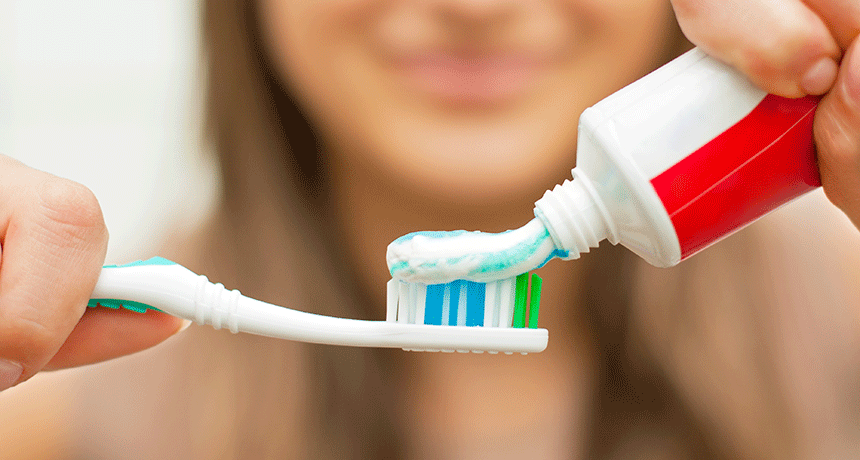Changing toothpastes? Change your toothbrush
Toothbrushes can absorb an antimicrobial chemical then release it after users switch toothpastes

The bristles of your toothbrush can absorb triclosan from toothpaste, a new study shows. Later, that chemical can come out again and expose your mouth.
TomFreeze/iStockphoto
Some popular toothpastes contain an germ-killing chemical called triclosan. Studies have shown that it may help fight the bacteria behind gum disease. But after the U.S. government banned triclosan from soaps and other cleaning products, many people decided to steer clear of the chemical in other products too. Many switched to triclosan-free toothpastes. A new study has now shown that may not help — unless users also got a new toothbrush. Why? Triclosan can stick around in toothbrushes, exposing people once again after they turn to a new toothpaste.
In 2016, the U.S. Food and Drug Administration banned triclosan and 18 other antiseptic chemicals from use in soaps. There was little evidence that the chemicals actually helped to prevent the spread of germs. What’s more, studies showed they could pose health risks, cause problems in the environment or contribute to antibiotic resistance. Triclosan was thought to do all three.
Yet it wasn’t banned from toothpastes. The reason: Some data showed that it might help fight gum disease. Still, many people switched toothpastes when they realized theirs contained the controversial chemical.
Jie Han and Baoshan Xing are environmental chemists. They work at the University of Massachusetts in Amherst. Their team has studied how various materials absorb different types of chemicals. After the FDA ban, they began to wonder whether triclosan sticks around in toothbrushes.
Brush, brush, brush
To probe that, they teamed up with chemists and engineers in Connecticut and New Zealand. The group chose 22 different types of toothbrushes that are popular in the United States. These ranged from full-sized brushes for adults to pea-sized ones for little kids. The brushes also varied in their features. Some had only nylon bristles. Others also had polishing cups and cheek/tongue cleaners made from a polymer called an elastomer (Ee-LAS-toh-mur). The researchers also bought 21 types of toothpaste. Six of them contained triclosan.
They mixed one part toothpaste with three parts of a chemical mix that mimics saliva. This created a “slurry.” It resembled what develops inside the mouth when brushing your teeth.
The researchers poured the slurry into a straight-sided vial. Then they brushed the inside of that container with the selected toothbrush for two minutes. They repeated this process up to 168 times. That’s equivalent to the number of times a person would use a toothbrush over a three-month period. (Dentists recommend that people get a new toothbrush every three months.)
Then the researchers tested the brushes and mixtures for triclosan. They didn’t want to test every single bristle. And they didn’t have to. They knew how much triclosan had been in the toothpaste applied to each toothbrush. They just subtracted how much ended up in the slurry. This told them how much must have been absorbed by the brushes.
Most brushes absorbed the triclosan from the toothpaste slurry. They accumulated the most during the first few times they were used. But they continued to pick up a little more with each additional use (just not as much as at the beginning).
The total amount that was absorbed depended on the brush. Those with added features generally absorbed much more than those with bristles only. That’s because these “accessories” are made of a different material than the bristles, Han explains. That material is better at absorbing the triclosan.
What goes in may come out
The researchers then looked at what would happen if someone switched to a toothpaste that contained no triclosan. Would the triclosan in that toothbrush now leach out into the mouth from the bristles?
To find out, the group repeated the experiment using brushes from the first experiment that had absorbed triclosan. Now, the only source of the triclosan would be those old brushes. And sure enough, triclosan leached into the slurry after brushing with a triclosan-free toothpaste. It did so again and again after each brushing.
The researchers reported their findings in the November 7, 2017 Environmental Science & Technology.
These data show that switching from a triclosan-containing toothpaste to a brand free of this chemical won’t prevent exposure, says Margaret James. She’s a chemist at the University of Florida in Gainesville. She was not involved with the study. “Unless a new toothbrush is used with the triclosan-free toothpaste,” she says, exposure to the chemical may not go away.
“This may seem wasteful,” Han concedes, but the best way to ensure that this exposure ends is to switch to a new toothbrush any time you switch toothpastes. People also may lower their exposures by choosing to use brushes that have only bristles. “We found these [bristles] accumulate much smaller amounts of triclosan” than other brushes. Another benefit, she notes, is that they also tend to cost less.







